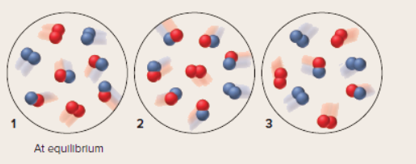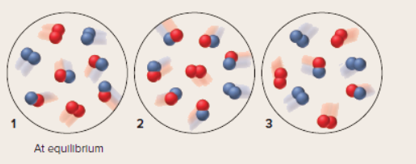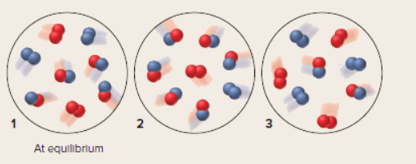
(a)
Interpretation : The

Concept Introduction :
Expression for the equilibrium constant is as follows:
Here,
(b )
Interpretation : The direction of the reaction should be interpreted when the reaction is not at equilibrium.

Concept Introduction :
Expression for equilibrium constant is as follows:
(c)
Interpretation : The effect of the rise in the T on the amount of product should be interpreted when the reaction is at equilibrium.

Concept Introduction:
Expression for equilibrium constant is as follows:
Want to see the full answer?
Check out a sample textbook solution
Chapter 17 Solutions
Chemistry: The Molecular Nature of Matter and Change
- At a certain temperature, K=0.29 for the decomposition of two moles of iodine trichloride, ICl3(s), to chlorine and iodine gases. The partial pressure of chlorine gas at equilibrium is three times that of iodine gas. What are the partial pressures of iodine and chlorine at equilibrium?arrow_forwardShow that the complete chemical equation, the total ionic equation, and the net ionic equation for the reaction represented by the equation KI(aq)+I2(aq)KI3(aq) give the same expression for the reaction quotient. KI3 is composed of the ions K+ and I3-.arrow_forwardFor the system SO3(g)SO2(g)+12 O2(g)at 1000 K, K=0.45. Sulfur trioxide, originally at 1.00 atm pressure, partially dissociates to SO2 and O2 at 1000 K. What is its partial pressure at equilibrium?arrow_forward
- Consider the following system at equilibrium at 25C: PCl3(g)+Cl(g)PCl5(g)G=92.50KJ What will happen to the ratio of partial pressure of PCl5 to partial pressure of PCI3 if the temperature is raised? Explain completely.arrow_forwardFor the reaction N2(g)+3H2(g)2NH3(g) show that Kc = Kp(RT)2 Do not use the formula Kp = Kc(RT)5n given in the text. Start from the fact that Pi = [i]RT, where Pi is the partial pressure of substance i and [i] is its molar concentration. Substitute into Kc.arrow_forwardIodine chloride decomposes at high temperatures to iodine and chlorine gases. 2ICl(g)I2(g)+Cl2(g)Equilibrium is established at a certain temperature when the partial pressures of ICl, I2, and Cl2 are (in atm) 0.43, 0.16, and 0.27, respectively. (a) Calculate K. (b) If enough iodine condenses to decrease its partial pressure to 0.10 atm, in which direction will the reaction proceed? What is the partial pressure of iodine when equilibrium is reestablished?arrow_forward
- Distinguish between the terms equilibrium constant and reaction quotient. When Q = K, what does this say about a reaction? When Q K, what does this say about a reaction? When Q K. what does this say about a reaction?arrow_forwardThe equilibrium constant Kc for the synthesis of methanol, CH3OH. CO(g)+2H2(g)CH3OH(g) is 4.3 at 250C and 1.8 at 275C. Is this reaction endothermic or exothermic?arrow_forwardKc = 5.6 1012 at 500 K for the dissociation of iodine molecules to iodine atoms. I2(g) 2 I(g) A mixture has [I2] = 0.020 mol/Land [I] = 2.0 108 mol/L. Is the reaction at equilibrium (at 500 K)? If not, which way must the reaction proceed to reach equilibrium?arrow_forward
- Write the equilibrium constant expression for each reaction in terms of activities, simplifying where appropriate. a C(s)+O2(g)CO2(g) b P4(s)+5O2(g)P4O10(s) c 2HNO2(g)+3Cl2(g)2NCl3(g)+H2(g)+2O2(g)arrow_forwardWrite an equation for an equilibrium system that would lead to the following expressions (ac) for K. (a) K=(Pco)2 (PH2)5(PC2H6)(PH2O)2 (b) K=(PNH3)4 (PO2)5(PNO)4 (PH2O)6 (c) K=[ ClO3 ]2 [ Mn2+ ]2(Pcl2)[ MNO4 ]2 [ H+ ]4 ; liquid water is a productarrow_forwardYou place 0.600 mol of nitrogen, N2, and 1.800 mol of hydrogen, H2, into a reaction vessel at 450C and 10.0 atm. The reaction is N2(g)+3H2(g)2NH3(g) What is the composition of the equilibrium mixture if you obtain 0.048 mol of ammonia, NH3, from it?arrow_forward
 Chemistry & Chemical ReactivityChemistryISBN:9781337399074Author:John C. Kotz, Paul M. Treichel, John Townsend, David TreichelPublisher:Cengage Learning
Chemistry & Chemical ReactivityChemistryISBN:9781337399074Author:John C. Kotz, Paul M. Treichel, John Townsend, David TreichelPublisher:Cengage Learning Chemistry & Chemical ReactivityChemistryISBN:9781133949640Author:John C. Kotz, Paul M. Treichel, John Townsend, David TreichelPublisher:Cengage Learning
Chemistry & Chemical ReactivityChemistryISBN:9781133949640Author:John C. Kotz, Paul M. Treichel, John Townsend, David TreichelPublisher:Cengage Learning General Chemistry - Standalone book (MindTap Cour...ChemistryISBN:9781305580343Author:Steven D. Gammon, Ebbing, Darrell Ebbing, Steven D., Darrell; Gammon, Darrell Ebbing; Steven D. Gammon, Darrell D.; Gammon, Ebbing; Steven D. Gammon; DarrellPublisher:Cengage Learning
General Chemistry - Standalone book (MindTap Cour...ChemistryISBN:9781305580343Author:Steven D. Gammon, Ebbing, Darrell Ebbing, Steven D., Darrell; Gammon, Darrell Ebbing; Steven D. Gammon, Darrell D.; Gammon, Ebbing; Steven D. Gammon; DarrellPublisher:Cengage Learning Chemistry: The Molecular ScienceChemistryISBN:9781285199047Author:John W. Moore, Conrad L. StanitskiPublisher:Cengage Learning
Chemistry: The Molecular ScienceChemistryISBN:9781285199047Author:John W. Moore, Conrad L. StanitskiPublisher:Cengage Learning Chemistry for Engineering StudentsChemistryISBN:9781337398909Author:Lawrence S. Brown, Tom HolmePublisher:Cengage Learning
Chemistry for Engineering StudentsChemistryISBN:9781337398909Author:Lawrence S. Brown, Tom HolmePublisher:Cengage Learning Chemistry by OpenStax (2015-05-04)ChemistryISBN:9781938168390Author:Klaus Theopold, Richard H Langley, Paul Flowers, William R. Robinson, Mark BlaserPublisher:OpenStax
Chemistry by OpenStax (2015-05-04)ChemistryISBN:9781938168390Author:Klaus Theopold, Richard H Langley, Paul Flowers, William R. Robinson, Mark BlaserPublisher:OpenStax





